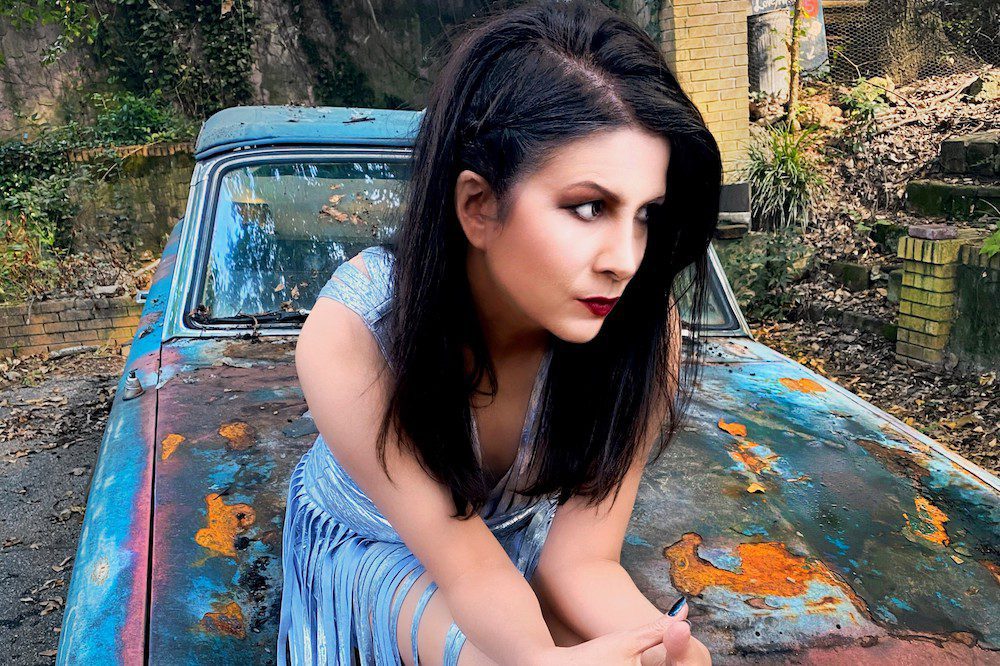INTERVIEW: Introducing Samsaya

Identity can be a tricky thing. Sampda Sharma, who sings ultra catchy tunes as Samsaya, knows that better than most. On her debut album, Bombay Calling, out later this year on BMG, Samsaya revisits her heritage and reconciles her many identities while forging a completely new brand of pop.
As an Indian girl growing up in Norway, Samsaya struggled to find a place where she she fit. “My parents were like a generation behind because they had 70’s India in their mind when they came to Norway. So they were raising me with my friends’ grandparents’ morals. It was really weird,” she says of her multicultural childhood when we spoke over the phone. Caught between the conservative ideals her parents instilled in her and and the youthful ways of her Norwegian friends, she quickly tired of being told what to do and who to be.
“It was hard having all those cultures when I was a teenager because there were so many rules. There were rules at school, rules at home, and it didn’t match. And being a girl there was a different set of rules, especially in Indian culture” she says. “That added into a really weird scenario because I’ve always been a bit boyish. I almost decided to be because I was like nobody’s gonna tell me I can’t do stuff. That’s not gonna happen.” So she got comfortable with doing the exact opposite of what was expected of her. “It’s been like that my whole life. When somebody tries to make me do something I just don’t get into it. I just have to find things myself.”
Everything changed when Samsaya heard Dinah Washington’s “Mad About the Boy” in a Levi’s commercial. “I remember being really young and going ‘Ah! I want to sing like that!’ She had this trumpet voice and it was so sensual,” she reminisces. “For a kid who had never experienced anything similar to that emotion, I think it was my first real sensual moment. It was really when music just touched me.” That music provided a way for Samsaya to deal with the frustrations she felt as a child. “I had all these emotions, almost fits in a way. I needed to put that into something. I think that’s how music became a very important part of myself.”
That Dinah Washington’s song resonated with Samsaya in a way traditional and religious music had not is telling of her rebellious nature. “My parents knew that I was always singing but I guess they wanted me to do more classical stuff and be more proper with the music. I always knew that it was a passionate thing for me, and I couldn’t do it ‘proper’. I just wanted to do it the way it felt right.” Though she admits that spiritual music can have similar characteristics, hearing Washington’s song felt different. “I could see that it was forbidden. Maybe that’s why it was exciting. Her voice and the attitude, the sensualism. It felt dangerous.”
It’s fitting, then, that Samsaya’s first single is about bucking expectations and traditions. On “Stereotype”, she joyously proclaims “I’ll just dance to whatever I like / I don’t need it to be black or white / I’m not down with your stereotype” and invites the whole world to come dancing with her despite any perceived differences. It’s partly autobiographical, Samsaya explains. “Growing up looking not Norwegian, being Indian, not feeling Indian, kind of gives you awareness about that situation. You are very aware of the feeling that you don’t necessarily look like what you are supposed to be in other people’s eyes.” By putting these feelings to a pop song that is essentially about loving music, she’s made the emotions universal. “I just wanted to actually make it simple so people could just feel it in a movement, a dance move. I think it’s a feeling we all can feel. That’s where I think pop music is great – it can really simplify something enough to be inviting, not something you fear.“
The messages here feel extremely prescient in light of the controversy that surrounded artists like Miley Cyrus last year when she twerked in her infamous “We Can’t Stop” video and chose to use women of color as props, supposedly in an effort to re-brand her own sexuality. Miley’s nods to hip-hop felt like a cheap ploy, but Samsaya achieves a kind of carefree authenticity, and it’s not happening solely because of her experiences of feeling otherness. The beat for “Stereotype” recalls the buoyancy of OutKast’s “Hey-Ya”, a song that obliterated boundaries with it’s cross-genre popularity when it was released. Similarly, “Stereotype” points out that music can be a bridge between cultures, and that sometimes all it takes to unite us is a good dance beat.
When filming the video, Samsaya returned to India, and found that she wasn’t as removed from her heritage as she had assumed. “When I was alone in India with four people from my team and I was the only one who could speak Hindi, people were really impressed. I was so flattered by that. It helped build my self esteem.” In many ways, Bombay Calling is a record of finding identity, a document of a journey back to her roots. She titled the record as such because, in her words, “Bombay was calling me!” She vividly remembers family members half a world away calling in the middle of the night because of the time difference. “Picking up the phone, still thinking you are dreaming… India was a dream to me growing up. All the places and faces that I had seen in my parents’ photos or heard them talk about. I’ve felt the attraction just grow with the years. While writing the album I felt it even stronger, and I guess I just really realized it then, that these songs are all a journey to and from India, not only physically but mentally and spiritually as well.”
She was selective though, about including traditional Indian sounds and elements on the record. “I know some musicians here in Norway that have Indian backgrounds. I didn’t want to put them in just because I’m Indian, I wanted to make it come from me if that’s gonna come out in any way.” She included bansuri on album closer “My Mind” for its peaceful sound, one that she recalls from her childhood. “It’s like a bamboo flute that sounds so beautiful and it’s a very traditional instrument in India. I had an uncle who played it and I heard it a lot growing up. So it’s also like traveling back to that feeling of being a kid again.” When she was in the UK, she found a musician who could play what she heard in her mind on the flute. “I thought he was Indian because his name is Timor, but he was actually British. He’d lived twenty years in India and he’d learned how to play really well. And he also spoke amazing Hindi. It was so great to realize that the world really is a melting pot now, because I had this British guy speaking Hindi to me. We really kind of mixed it and mashed it up in a fun way.”
In the end, her carefully curated restraint with these well-placed flourishes keep the record from veering into pastiche or caricature. The thudding percussion on the title track is accented with slickly produced synths that give it a modern, almost video-game feel. The dancehall vibes of “Love Maze” give way to a sinuous hook; it’s easy to picture it blasting late-night in a smokey club. “First Time” is another highlight, channeling an almost eighties pop groove, the kind you’d hear in Blondie’s new-wave infused disco or Madonna’s classic dance gems. It’s followed by ecstatic love song “U & Me”, bursting with a hyper, infatuated energy. Vocally, Samsaya has achieved the very sound she envied as a kid, her voice soaring and bubbling, reminiscent of pop stars like Gwen Stefani, Solange, and Robyn, letting it loose over infectious beats. When asked to put the sound into words, Samsaya chooses one that’s highly appropriate: magma. “It’s a Greek word for ‘mixture’. And it’s actually the center of the world, inside the earth, like lava. So it’s like Magma pop. It’s a mixture, it’s a lot of emotion and it’s really warm, sometimes scorching hot.”
Bombay Calling is a fun record, to be sure. There are moments of uplifting bliss, like “Good With the Bad” in which Samsaya sings “Tomorrow is not today,” describing her hardships alongside her successes. It provides a clear portrait of her positivity and openness, something she represents visually by drawing a heart over her eye when she performs. “The heart ritual itself really helps me to see things with openness. I think it’s important to question and wonder instead of presuming or guessing, diffusing any feelings of fear through music. If I feel fear or anger I find music to be the perfect cure.”
Samsaya is looking forward, of course, to playing her songs for the world. “The emotions on the album, I really wanna share. I can travel the world and play it for everyone. I love to play live and I can’t wait to do that.” In the studio, she cranked up the tracks, often singing live over producer Fred Ball’s beats, writing as she went. “I wanted it really as live as it can be, just have that energy in the room, to be able to take trips like that in the studio. It was just fun, it was the way I think music should be.” She’ll make her live US debut at SXSW in Austin this March, followed by tour dates in San Francisco, Los Angeles, and New York City.
For now, she’s in Stockholm, having moved there from Oslo a few years ago. She says that “home” is “anywhere I can create music. I found out that it’s not like a place, it’s more what I surround myself with at that place, really. I feel ‘home’ very many places in the world. I’m lucky like that. I don’t have necessarily one spot that I feel is home except maybe when I’m sitting and creating something.” She does find an inspiring energy in NYC, saying of a recent trip here “I love the mixture of people. You wanna just tap into it and you wanna just start making something out of it immediately. I think it’s the greatest thing and it should be all around the world, it should be that multicultural. It’s very, very positive, it brings out the best in us. Our uniqueness is really what makes us strong. And makes it exciting and makes life worth living.”
Samsaya is nothing if not unique. For her, making music is about processing experiences and emotions, being open and breaking rules. Her outlook is as refreshing spiritually as it is sonically, ensuring that this very gifted gal will soon be taking the world by storm.







